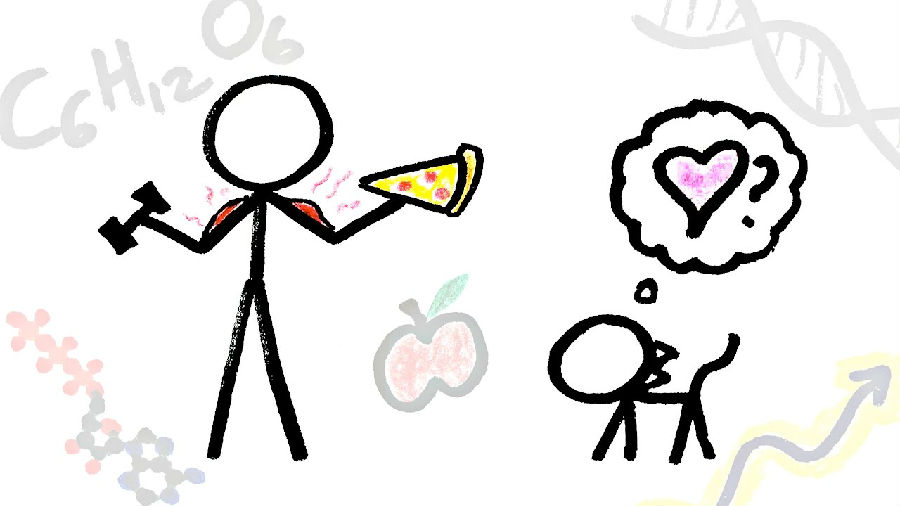Astrobiologist Michael Russell once said that "the purpose of life is to hydrogenate carbon dioxide."
天体生物学家迈克尔·拉塞尔曾说过,“生命的目的是为了氢化二氧化碳。”
Or as Nobel prize-winning physiologist Albert Szent-Gyorgyi put it, "life is nothing but an electron looking for a place to rest."
诺贝尔奖得主生理学家圣捷尔吉·阿尔伯特说,“生命只不过是一个寻找休息之地的电子。”
While these aphorisms might not capture the "meaning of life" that most of us look for,
虽然这些格言并不能代表我们大部分人对“生命意义的追寻,”
their point is that living organisms ultimately depend on and facilitate the universe's tendency to increase entropy.
但他们的观点是,生命有机体最终依赖并促进了宇宙熵增加的趋势。
That may seem counter-intuitive, since living beings are themselves highly organized, while entropy is a measure of disorder.
这似乎是反直觉的,因为生物本身是高度有序的,而熵是一种无序的度量。
But as we know, complexity is not the same thing as order. Every organism, just by living and breathing, acts to increase the entropy of the universe.
但我们知道,复杂性和秩序是两回事。每个生物体,单凭生存和呼吸,就能增加宇宙的镝。
Think of a photon arriving from the Sun, packed with useful energy.
想象一个光子从太阳发出来,充满了可用的能量。
It can be captured by a plant or microorganism that uses photosynthesis to store that energy in the form of sugar.
植物或微生物可以利用光合作用将能量以糖的形式储存起来。
But the sugar doesn't contain quite as much useful energy as the original photon – some of the energy ends up heating the plant and its environment.
但是糖中所含的有用能量并不像最初的光子那么多——其中一些能量最终会加热植物和它的环境。
An animal like us eats the sugar, and uses its energy to create molecules of ATP, adenosine triphosphate.
动物,比如人类吃糖,并利用能量创造制造ATP分子,即三磷酸腺苷。
ATP is like a little power-pack of energy that can be sent to a part of the body where it might be helpful,
ATP就像一个小能量包,被送往身体可能有用的部分,
but ATP doesn't have quite as much useful energy as the sugar that went into making it –
但ATP中可用的的能量又不及用来制造它的糖——
some of that useful energy got lost pushing around all the cell machinery that makes the ATP.
其中一些有用的能量在推动制造
ATP的细胞机制时丢失了。

The proteins in your muscles utilize the energy in ATP to contract, so that you can lift a barbell or a slice of pizza.
你肌肉中的蛋白质利用ATP中的能量进行收缩,这样你就能够举起一个杠铃或一片披萨。
But not all of the useful energy of the ATP goes into lifting the pizza – as before, some of it is degraded into noise and heat.
但并不是所有ATP的有用能量都被用来拿披萨——和以前一样,其中一些被分解成噪音和热量。
Not only that, ATP's useful energy can also be used to repair broken-down cells or organs, again becoming less useful in the process.
不仅如此,ATP的有用能量还能被用于修复受损的细胞或器官,但在这个过程中,它的有效性也会减弱。
The pattern here is obvious: every step along the way, the energy in that original photon is gradually degraded, entropy increases,
此处模式非常明显:在这条路上每走一步,原光子中的能量就会逐步衰退,而镝则会增加,
and at the end all that's left is an organized but slightly warmer plant and cell and muscle,
最终所能留下来的是保持有序但稍微温暖的植物、细胞和肌肉,
plus some high-entropy infrared light that gets radiated out into the universe.
再加上一些高熵红外光辐射到宇宙中。
Energy transforms from useful to useless in the cause of keeping organisms like us alive.
能量从有用到没用,是我们这些生物体生存的过程。
In fact, life itself might have arisen because of entropy.
事实上,生命本身因镝而起。
The early Earth had pockets of low-entropy conditions full of useful energy, like warm alkaline vents on the ocean floor.
在其地球有低嫡环境,其中充满了有用的能量,比如海底温暖的碱性喷口。
But there may have been no simple chemical reaction that could take advantage of that energy,
但可能没有一种简单的化学反应能够利用这种能量,
use up its usefulness, and allow the entropy to increase.
将它消耗殆尽,让镝得以增长。
There were, however, more complicated chains of reactions that could do the job.
然而,有更复杂的反应链可以完成这个任务。
In just the right circumstances, an appropriate network of chemical reactions
在适当的环境中,一个合适的化学反应网络
might find a way to sustain itself by tapping into the useful energy in its environment.
或许可以找到一种通过利用环境中有用的能量来维持自身的方法。
Some networks might have become embedded in molecular membranes, the precursors of cell walls,
一些网络可能已经嵌入到分子膜(细胞壁的前体)中,
and broken away from their point of origin, becoming the first "living" organisms.
并从它们的起点断裂,成为第一个“活的”生物体。
Maybe that's how life began: a complex combination of chemical reactions that figured out how to tap into otherwise unavailable useful energy.
或许这就是生命的起源:一串复杂的化学反应,找到第一无二的方法利用可用的能量。
We can tell a similar story about why stars shine.
我们可以用类似方法讲述星星为什么发光的故事。
Hydrogen nuclei have a ton of useful, low-entropy nuclear energy to release -- if you can get them to fuse together into helium.
氢原子核有大量有用的、低熵的核能需要释放——如果你能让它们聚变成氦的话。
But there's a big barrier to getting that to happen – fusion is hard!
但要做到这一点还有一个很大的障碍——核聚变很难!
And yet, the cores of stars do the job marvelously, so stars, like life, also survive because of the increase of entropy throughout the universe.
然而,恒星的核心非常出色地完成了这项工作,所以恒星,像生命一样,也能生存下来,因为整个宇宙的熵增加了。
Our sun takes a low-entropy fuel source and converts it into higher entropy energy.
我们的太阳采用低熵的燃料源,并将其转化为高熵的能量。
Life takes that higher-entropy energy as a fuel source and converts it into even higher-entropy energy.
生命需要将更高熵能量作为燃料源,并将其转化成更高镝能量。
In a very real sense, the purpose of life is to continue the mission of the stars.


